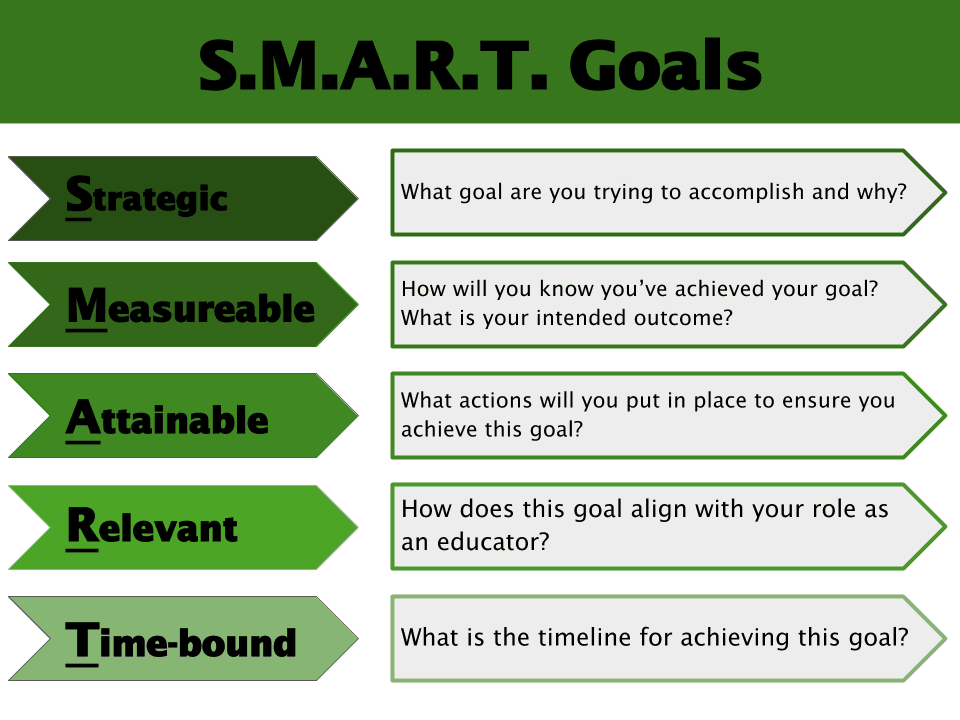Every August, as the summer days wind down and the school year approaches, I find myself reflecting on the previous year as I make plans for the new school year. What went well that I’d like to maintain? Or, perhaps even more importantly, what would I like to improve upon?
Just being aware of the goals we want to achieve isn’t the same thing as making those goals happen, however. I’ve learned that the act of putting my goals down on paper for the new school year really helps me stay focused. But what’s the best way to do this? Year after year, I tried different goal-setting methods, but I found it always seemed to be like those New Years’ resolutions: Such a great idea in January, but long forgotten by February.
So how could I map out my goals in August and stick with them month after month, no matter how busy my day-to-day schedule might be? After doing some research, I came across the S.M.A.R.T. goal format. While this goal-setting approach is most often used by those in the corporate world, with a few tweaks here and there, they can easily become the educator’s new best friend.
Have you heard of the S.M.A.R.T. goal format? Here’s a quick breakdown:
 Now, for those of you, who, like me, learn better from examples, here’s one of my own S.M.A.R.T. goals for this new school year, which revolves around the following:
Now, for those of you, who, like me, learn better from examples, here’s one of my own S.M.A.R.T. goals for this new school year, which revolves around the following:
Strengthening My Professional Learning Network (PLN)
Specific: To extend my professional learning network. Why? Having a collaborative network of educators to engage with, both face-to-face and virtually, is pivotal to continuing my own learning as an educator. Talking with my peers or on an online forum about the best way to implement a certain standard or a creative way to engage students with a piece of text is much more enjoyable than insisting on working solo.
Measurable: I will participate in at least two Twitter chats a month (one being the monthly #CoreAdvocates chat), find and follow one new educational blog each month, participate in one book study (whether virtually or face-to-face) each semester, and join and engage with Google+ communities.
Achievable: To achieve this goal, I need to do several things. I need to schedule the time on my calendar for Twitter chats so I don’t forget to participate. I also need to research how to use Google+ communities as this online PLN is relatively new to me.
Relevant: One of our district’s goals is to promote lifelong learning. By extending my own professional learning network, I’m embracing the district goal by making it a personal goal. Daily, I’m able to glean helpful suggestions and ideas from my PLN whether it’s on Twitter, Facebook, or by chatting with my colleague across the hall about her new lesson she’s working on.
Timeline: August 2017—June 2018
When I sit down to create my goals year after year, I always keep my teaching standards in mind. At the end of the day, my job is to support student learning. Because of this, it’s important for me to ensure my own personal classroom goals align with what’s best for my students. So while expanding my PLN might not necessarily seem as though it’s focusing on the standards I need to teach, in reality, the two are very much aligned. When I have a problem, it’s my PLN who can help me. If I’m struggling with finding an engaging text to teach a reading literature standard, I can tweet out a request for help or I can walk down the hall and ask a team member. It’s important to me that we all remember we’re in this together. Our job is to not just to support our students as they continue their learning from year to year, but to support our peers in their learning venture as well. Without my PLN, I might have never discovered my best lessons. And that is why I’m focusing this year on expanding my PLN. I refuse to stop learning, because if I do, not only do I suffer, but so do my students.
You may be thinking that creating a S.M.A.R.T. goal is time-intensive. Why go to all that trouble? The answer: while it’s easy to just verbalize a goal with your colleagues or to jot out a goal on a post-it note, eventually you and your colleagues will get bogged down with the day-to-day tasks in the classroom and forget about your goal. The post-it note will get covered up with other post-it notes. This is why I utilize the S.M.A.R.T. format, because identifying not just a goal but creating an in-depth plan of action to achieve that goal is what makes S.M.A.R.T. goals work. While I often have to grapple with identifying all the pieces to my S.M.A.R.T. goals, I find that, because of that productive struggle, I’m much more vested in seeing my goal through to the end. Unlike those New Year’s goals that are long forgotten by February, I’m much more likely to find success with my classroom goals now.
So, I ask you, what’s your S.M.A.R.T. goal going to be this year? Find a pencil, pour a cup of coffee, and get started with goal-setting using the S.M.A.R.T. goal template attached to this post. I encourage you to tweet your S.M.A.R.T. goal to me using my Twitter handle @susanhitt and use #CoreAdvocates so we can work as a community to support each other in our ventures.

















I have to wonder what other profession requires professionals to create specific goals for themselves and submit them to their superiors on an annual basis? Are medical doctors required to state how many patients they will ‘save’ over the course of the year and how they will ‘achieve’ their goal???
I agree. It’s ridiculous. We do so much of what I call “busy work”. Many of things teachers already do informally in their heads now have to be written and submitted formally to our superiors.
The answer is Yes! SMART goals do not come from education but rather business. If done correctly, they should help you grow as an educator and help to keep you focused on YOUR professional goals. Honestly, the SMART goal strategy is a great one to utilize in your personal life as well.
I’m actually looking for an article to help others learn more about using SMART goals during lesson delivery. I used them for writing IEPs, but now I would like to inform my colleagues about how SMART goals can be applied in each lesson. Thanks for this article, but it’s not tailored to my needs. 🙂
Interested to hear if you found any other useful websites?
My SMART goal for each year are the same – to survive the year with my sanity in tact.
When I looked up SMART goal, I saw that this concept is facilitated by Pearson, the writer of most of our state’s program.
The perception is that if we consciously set goals, and show students what it is that they must attain, they will grow toward that goal. While it makes sense, it is ultimately tested. The people that write tests expect students to apply knowledge. While this makes sense for upper elementary and beyond, it does not always make sense for lower elementary, who developmentally are much more literal.
Pearson has been shaping education according to business models of data collection, test and retest. While it might make sense in some areas, the needs of students are often set aside for the results.
SMART goal are in fact a result of a bottom line driven business. They’re meant to increase productivity of workers and improve their added value to the company’s profit by diminishing as as possible their cost per head vs input ( the labor they provide ) .In simple terms , whenever there is a KPI set by a business to maximize their profit vs their expenses , SMART goals need to be set. Which put, in a lot of situations , a a needless stress on workers , especially in more creative jobs , such as marketing , product development , editing …etc. Which makes me wonder , why educators and teachers are required to do this ? aren’t they paid to teach ? it doesn’t make any sense , because their goals are bound by their student’s goals. Example : my goal is to make my student a future engineer and a good human being 🙂 , SMART that capitalism !
I have to agree with Betty Ervin. This is busy work, and disagree with the person that brought up corporate America.